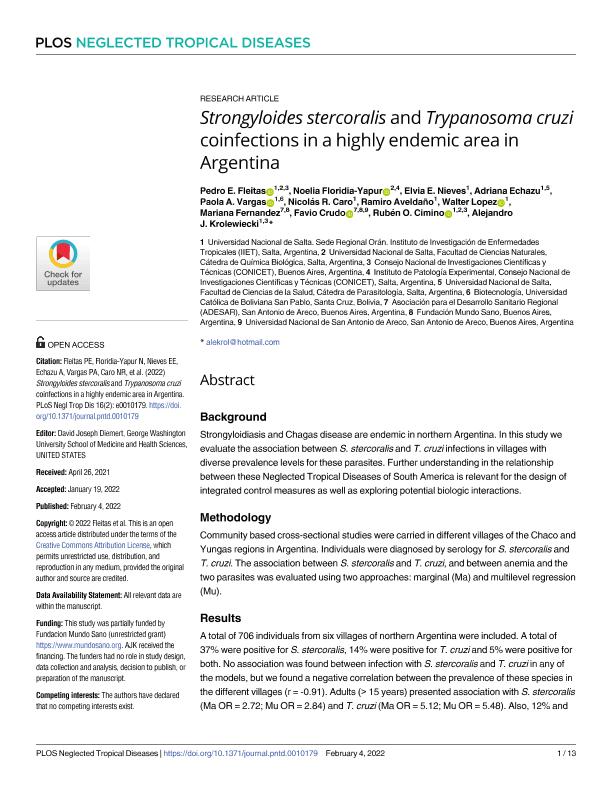Artículo
Strongyloides stercoralis and Trypanosoma cruzi coinfections in a highly endemic area in Argentina
Fleitas, Pedro Emanuel ; Floridia Yapur, Noelia Aldana del Rosario
; Floridia Yapur, Noelia Aldana del Rosario ; Nieves, Elvia Ester
; Nieves, Elvia Ester ; Echazú, Adriana
; Echazú, Adriana ; Vargas, Paola Anahí; Caro, Reynaldo Nicolás; Aveldaño, Ramiro; Lopez, Walter; Fernandez, Mariana; Crudo, Favio; Cimino, Rubén Oscar
; Vargas, Paola Anahí; Caro, Reynaldo Nicolás; Aveldaño, Ramiro; Lopez, Walter; Fernandez, Mariana; Crudo, Favio; Cimino, Rubén Oscar ; Krolewiecki, Alejandro Javier
; Krolewiecki, Alejandro Javier
 ; Floridia Yapur, Noelia Aldana del Rosario
; Floridia Yapur, Noelia Aldana del Rosario ; Nieves, Elvia Ester
; Nieves, Elvia Ester ; Echazú, Adriana
; Echazú, Adriana ; Vargas, Paola Anahí; Caro, Reynaldo Nicolás; Aveldaño, Ramiro; Lopez, Walter; Fernandez, Mariana; Crudo, Favio; Cimino, Rubén Oscar
; Vargas, Paola Anahí; Caro, Reynaldo Nicolás; Aveldaño, Ramiro; Lopez, Walter; Fernandez, Mariana; Crudo, Favio; Cimino, Rubén Oscar ; Krolewiecki, Alejandro Javier
; Krolewiecki, Alejandro Javier
Fecha de publicación:
02/2022
Editorial:
Public Library of Science
Revista:
Neglected Tropical Diseases
ISSN:
1935-2735
Idioma:
Inglés
Tipo de recurso:
Artículo publicado
Clasificación temática:
Resumen
Background Strongyloidiasis and Chagas disease are endemic in northern Argentina. In this study we evaluate the association between S. stercoralis and T. cruzi infections in villages with diverse prevalence levels for these parasites. Further understanding in the relationship between these Neglected Tropical Diseases of South America is relevant for the design of integrated control measures as well as exploring potential biologic interactions. Methodology Community based cross-sectional studies were carried in different villages of the Chaco and Yungas regions in Argentina. Individuals were diagnosed by serology for S. stercoralis and T. cruzi. The association between S. stercoralis and T. cruzi, and between anemia and the two parasites was evaluated using two approaches: marginal (Ma) and multilevel regression (Mu). Results A total of 706 individuals from six villages of northern Argentina were included. A total of 37% were positive for S. stercoralis, 14% were positive for T. cruzi and 5% were positive for both. No association was found between infection with S. stercoralis and T. cruzi in any of the models, but we found a negative correlation between the prevalence of these species in the different villages (r =-0.91). Adults (> 15 years) presented association with S. stercoralis (Ma OR = 2.72; Mu OR = 2.84) and T. cruzi (Ma OR = 5.12; Mu OR = 5.48). Also, 12% and 2% of the variance of infection with S. stercoralis and T. cruzi, respectively, could be explained by differences among villages. On the other hand, anemia was associated with infection with S. stercoralis (Ma OR = 1.73; Mu OR = 1.78) and was more prevalent in adults (Ma OR = 2.59; Mu OR = 2.69). Conclusion We found that coinfection between S. stercoralis and T. cruzi is not more frequent than chance in endemic areas. However, the high prevalence for both parasites, raises the need for an integrated strategy for the control of STH and Chagas disease.
Palabras clave:
Strongyloides stercoralis
,
Tripanosoma cruzi
Archivos asociados
Licencia
Identificadores
Colecciones
Articulos(CCT - SALTA-JUJUY)
Articulos de CTRO.CIENTIFICO TECNOL.CONICET - SALTA-JUJUY
Articulos de CTRO.CIENTIFICO TECNOL.CONICET - SALTA-JUJUY
Articulos(IPE)
Articulos de INST.DE PATOLOGIA EXPERIMENTAL
Articulos de INST.DE PATOLOGIA EXPERIMENTAL
Citación
Fleitas, Pedro Emanuel; Floridia Yapur, Noelia Aldana del Rosario; Nieves, Elvia Ester; Echazú, Adriana; Vargas, Paola Anahí; et al.; Strongyloides stercoralis and Trypanosoma cruzi coinfections in a highly endemic area in Argentina; Public Library of Science; Neglected Tropical Diseases; 16; 2; 2-2022; 1-13
Compartir
Altmétricas



